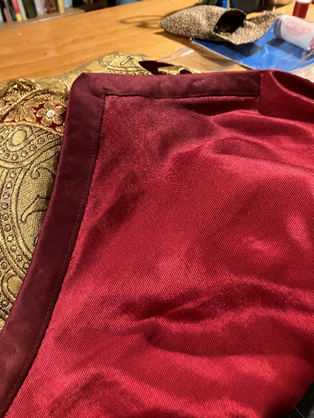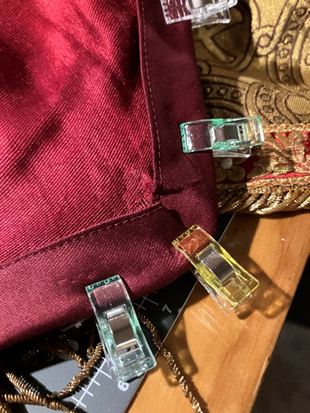I was asked to expand on my repair of a priestly garment that appeared in the ASG Notions a few months back. I have included the text submitted as well as more photos explaining or detailing my process.
"I was asked by our priest to reattach a clasp to a cope. However, when I received the garment all the
wefts had disappeared in the area where the clasp was to go, and the
surrounding material had little to no strength to secure the clasp. Having the advantage of a textile conservator
in the family (my daughter- Kayla Silvia Winokurzew) she presented me with two
options for repair – recreating the weave by inserting new wefts or putting
nylon netting (tuille) over the area and stitching around the area to give it
more strength. As this condition existed
in the upper front portion of both sides of the garment and around the neckline
area, I opted for the tuille and placed a self-constructed 1” bias tape to cover
the tuille, so that the wearer would not be irritated by the slight roughness
of the tuille. The completion of this
task involved a lot of hand sewing as there was no way that I was going to open
the garment at the many seams that existed due to the fringe and other
embellishments that adorned the garment.
As it was, I had to open the entire neckline and a good 6” on the front
to attach the tuille and the bias tape. Additional interfacing was also sown into the
cope under the lining where the clasps were to be attached as there was
previously only one thin layer of muslin. The garment itself weighed a good 20 pounds so
there was a lot of weight being carried by the two clasps. While working on the garment, I used a lot of
clips to ensure that the multiple layers of fabric stayed in place and was
grateful for the #10 needles obtained from taking Helen Haughey’s Couture Hand
Stitching Virtual class last year.
Although the final result may not be museum quality restoration, I am
extremely happy with the outcome, and hope that the garment will last another
50 years for use in future religious services.
I considered this project both a challenge for technique and color
compatibility, (oils from years of use had darkened the fabric around the front
and neck from its original true red) as well as an opportunity to visibly mend
a garment and further textile sustainability."
Other things to note, finding a compatible fabric was difficult, few exist that have do not have religious symbols such as crosses or paisley prints. A complimentary color was also had to find. The fabric chosen was a jacquard with a little bit of spandex, which was a benefit because I was using it on the neckline and on the front of the garment.
I hope this satisfies interested parties. This did take a lot of hand sewing and lots of time to complete.

 The tuille in place. The tuille is folded over about 3 times, so that the bias tape will have something of strength to hold on to.
The tuille in place. The tuille is folded over about 3 times, so that the bias tape will have something of strength to hold on to.
 The bias tape being positioned for attachment both on the underside of the lining and on the outside of the lining. NOTE: the additional tuille on the underside of the really frayed area.
The bias tape being positioned for attachment both on the underside of the lining and on the outside of the lining. NOTE: the additional tuille on the underside of the really frayed area.

 The finished inside of the garment with the binding attached
and the original label re-secured using misty fuse.
The finished inside of the garment with the binding attached
and the original label re-secured using misty fuse.








No comments:
Post a Comment